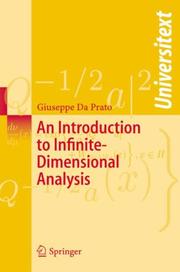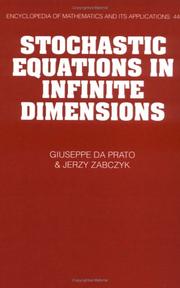| Listing 1 - 10 of 28 | << page >> |
Sort by
|
Book
ISBN: 3540290214 Year: 2006 Publisher: Berlin, Heidelberg : Springer Berlin Heidelberg : Imprint: Springer,
Abstract | Keywords | Export | Availability | Bookmark
 Loading...
Loading...Choose an application
- Reference Manager
- EndNote
- RefWorks (Direct export to RefWorks)
In this revised and extended version of his course notes from a 1-year course at Scuola Normale Superiore, Pisa, the author provides an introduction – for an audience knowing basic functional analysis and measure theory but not necessarily probability theory – to analysis in a separable Hilbert space of infinite dimension. Starting from the definition of Gaussian measures in Hilbert spaces, concepts such as the Cameron-Martin formula, Brownian motion and Wiener integral are introduced in a simple way. These concepts are then used to illustrate some basic stochastic dynamical systems (including dissipative nonlinearities) and Markov semi-groups, paying special attention to their long-time behavior: ergodicity, invariant measure. Here fundamental results like the theorems of Prokhorov, Von Neumann, Krylov-Bogoliubov and Khas'minski are proved. The last chapter is devoted to gradient systems and their asymptotic behavior.
Dimensional analysis. --- Functional analysis. --- Functional calculus --- Calculus of variations --- Functional equations --- Integral equations --- Physical measurements --- Distribution (Probability theory. --- Differential equations, partial. --- Functional Analysis. --- Probability Theory and Stochastic Processes. --- Partial Differential Equations. --- Distribution functions --- Frequency distribution --- Characteristic functions --- Probabilities --- Partial differential equations --- Probabilities. --- Partial differential equations. --- Probability --- Statistical inference --- Combinations --- Mathematics --- Chance --- Least squares --- Mathematical statistics --- Risk --- Differential equations, Partial.
Book
ISBN: 3642111041 364211105X Year: 2011 Publisher: Berlin ; London : Springer,
Abstract | Keywords | Export | Availability | Bookmark
 Loading...
Loading...Choose an application
- Reference Manager
- EndNote
- RefWorks (Direct export to RefWorks)
Lectures: J. Chazarain, A. Piriou: Problèmes mixtes hyperboliques: Première partie: Les problèmes mixtes hyperboliques vérifiant 1a condition de Lopatinski uniforme; Deuxième partie: Propagation et réflexion des singularités.- L. Gårding: Introduction to hyperbolicity.- T. Kato: Linear and quasi-linear equations of evolution of hyperbolic type.- K.W. Morton: Numerical methods for non-linear hyperbolic equations of mathematical physics.- Seminars: H. Brezis: First-order quasilinear equation on a torus.
Dynamics. --- Geometry, Hyperbolic. --- Geometry. --- Mathematics --- Physical Sciences & Mathematics --- Calculus --- Differential equations, Hyperbolic --- Differential equations --- 517.91 Differential equations --- Mathematics. --- Ergodic theory. --- Dynamical Systems and Ergodic Theory. --- Differentiable dynamical systems. --- Differential dynamical systems --- Dynamical systems, Differentiable --- Dynamics, Differentiable --- Global analysis (Mathematics) --- Topological dynamics --- Ergodic transformations --- Continuous groups --- Mathematical physics --- Measure theory --- Transformations (Mathematics) --- Dynamical systems --- Kinetics --- Mechanics, Analytic --- Force and energy --- Mechanics --- Physics --- Statics
Book
ISBN: 8876424970 8876424997 Year: 2014 Publisher: Pisa : Scuola Normale Superiore : Imprint: Edizioni della Normale,
Abstract | Keywords | Export | Availability | Bookmark
 Loading...
Loading...Choose an application
- Reference Manager
- EndNote
- RefWorks (Direct export to RefWorks)
This volume presents an introductory course on differential stochastic equations and Malliavin calculus. The material of the book has grown out of a series of courses delivered at the Scuola Normale Superiore di Pisa (and also at the Trento and Funchal Universities) and has been refined over several years of teaching experience in the subject. The lectures are addressed to a reader who is familiar with basic notions of measure theory and functional analysis. The first part is devoted to the Gaussian measure in a separable Hilbert space, the Malliavin derivative, the construction of the Brownian motion and Itô's formula. The second part deals with differential stochastic equations and their connection with parabolic problems. The third part provides an introduction to the Malliavin calculus. Several applications are given, notably the Feynman-Kac, Girsanov and Clark-Ocone formulae, the Krylov-Bogoliubov and Von Neumann theorems. In this third edition several small improvements are added and a new section devoted to the differentiability of the Feynman-Kac semigroup is introduced. A considerable number of corrections and improvements have been made.
Mathematics. --- Functional analysis. --- Measure theory. --- Probabilities. --- Probability Theory and Stochastic Processes. --- Functional Analysis. --- Measure and Integration. --- Distribution (Probability theory. --- Functional calculus --- Calculus of variations --- Functional equations --- Integral equations --- Math --- Science --- Distribution functions --- Frequency distribution --- Characteristic functions --- Probabilities --- Stochastic differential equations. --- Lebesgue measure --- Measurable sets --- Measure of a set --- Algebraic topology --- Integrals, Generalized --- Measure algebras --- Rings (Algebra) --- Probability --- Statistical inference --- Combinations --- Mathematics --- Chance --- Least squares --- Mathematical statistics --- Risk
Book
Year: 1976 Publisher: London: Academic press,
Abstract | Keywords | Export | Availability | Bookmark
 Loading...
Loading...Choose an application
- Reference Manager
- EndNote
- RefWorks (Direct export to RefWorks)

ISBN: 9783764372163 9780817672164 0817672168 3764372168 Year: 2004 Publisher: Basel: Birkhäuser,
Abstract | Keywords | Export | Availability | Bookmark
 Loading...
Loading...Choose an application
- Reference Manager
- EndNote
- RefWorks (Direct export to RefWorks)
Reaction-diffusion equations --- Navier-Stokes equations --- Ergodic theory --- Stochastic analysis

ISBN: 3540290206 9783540290209 3540290206 9783540290209 Year: 2006 Publisher: Berlin: Springer,
Abstract | Keywords | Export | Availability | Bookmark
 Loading...
Loading...Choose an application
- Reference Manager
- EndNote
- RefWorks (Direct export to RefWorks)
Book
Year: 1911 Publisher: Torino : Società Tipografico-Editrice Nazionale,
Abstract | Keywords | Export | Availability | Bookmark
 Loading...
Loading...Choose an application
- Reference Manager
- EndNote
- RefWorks (Direct export to RefWorks)
Book
ISBN: 3540172114 3540474080 0387172114 9783540172116 Year: 1987 Volume: 1236 Publisher: Berlin: Springer,
Abstract | Keywords | Export | Availability | Bookmark
 Loading...
Loading...Choose an application
- Reference Manager
- EndNote
- RefWorks (Direct export to RefWorks)
Stochastic processes --- 51 --- Mathematics --- 51 Mathematics
Book
ISBN: 3540515100 0387515100 3540482008 9783540515104 Year: 1989 Volume: 1390 Publisher: Berlin: Springer,
Abstract | Keywords | Export | Availability | Bookmark
 Loading...
Loading...Choose an application
- Reference Manager
- EndNote
- RefWorks (Direct export to RefWorks)
Stochastic processes --- Partial differential equations --- 51 --- Mathematics --- 51 Mathematics

ISBN: 0521385296 9780521385299 Year: 1992 Volume: v. 45[i.e. 44] Publisher: Cambridge: Cambridge university press,
Abstract | Keywords | Export | Availability | Bookmark
 Loading...
Loading...Choose an application
- Reference Manager
- EndNote
- RefWorks (Direct export to RefWorks)
The aim of this book is to give a systematic and self-contained presentation of the basic results on stochastic evolution equations in infinite dimensional, typically Hilbert and Banach, spaces. These are a generalization of stochastic differential equations as introduced by It and Gikhman that occur, for instance, when describing random phenomena that crop up in science and engineering, as well as in the study of differential equations. The book is divided into three parts. In the first the authors give a self-contained exposition of the basic properties of probability measures on separable Banach and Hilbert spaces, as required later; they assume a reasonable background in probability theory and finite dimensional stochastic processes. The second part is devoted to the existence and uniqueness of solutions of a general stochastic evolution equation, and the third concerns the qualitative properties of those solutions. Appendices gather together background results from analysis that are otherwise hard to find under one roof.
| Listing 1 - 10 of 28 | << page >> |
Sort by
|

 Search
Search Feedback
Feedback About UniCat
About UniCat  Help
Help News
News